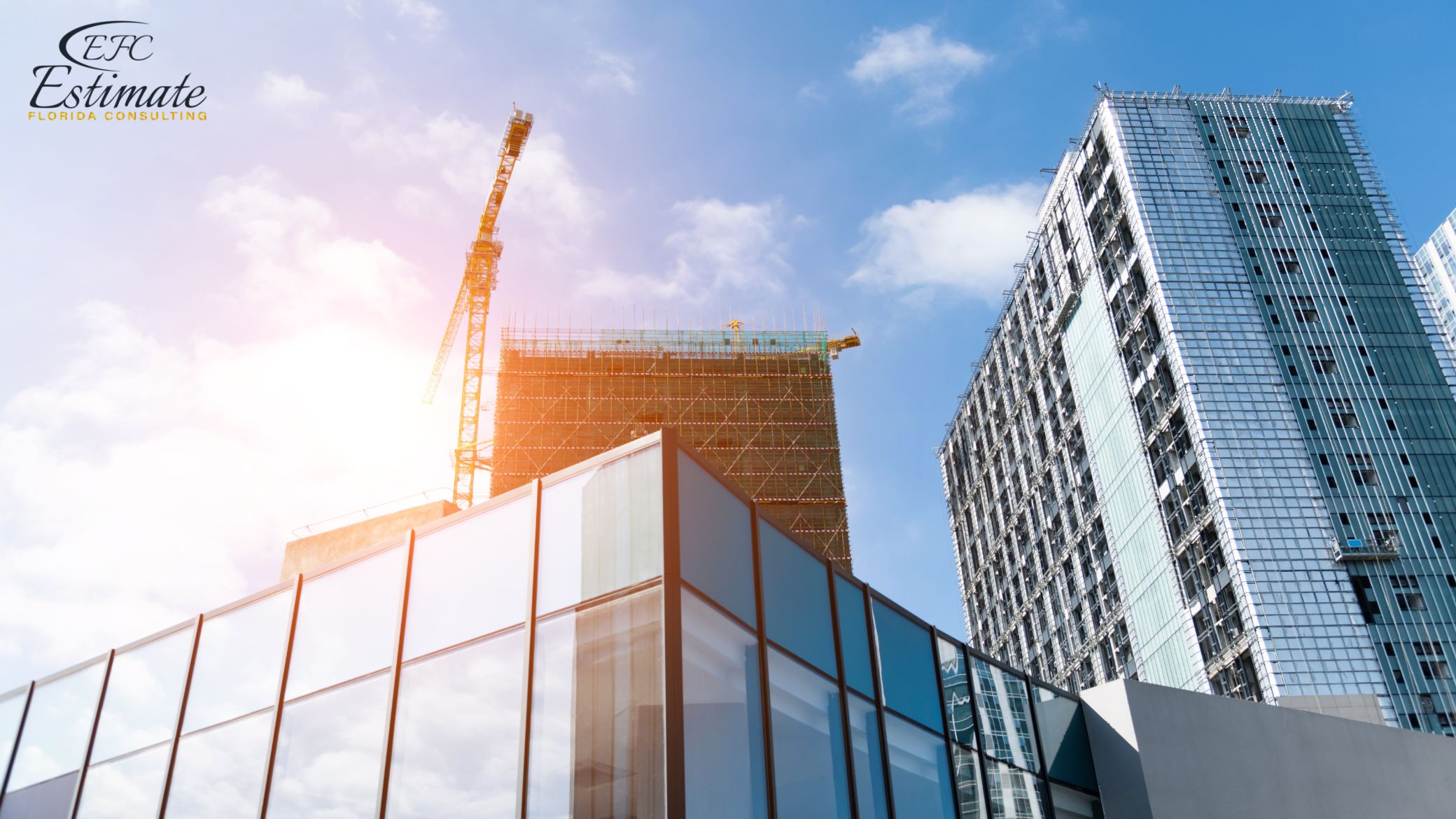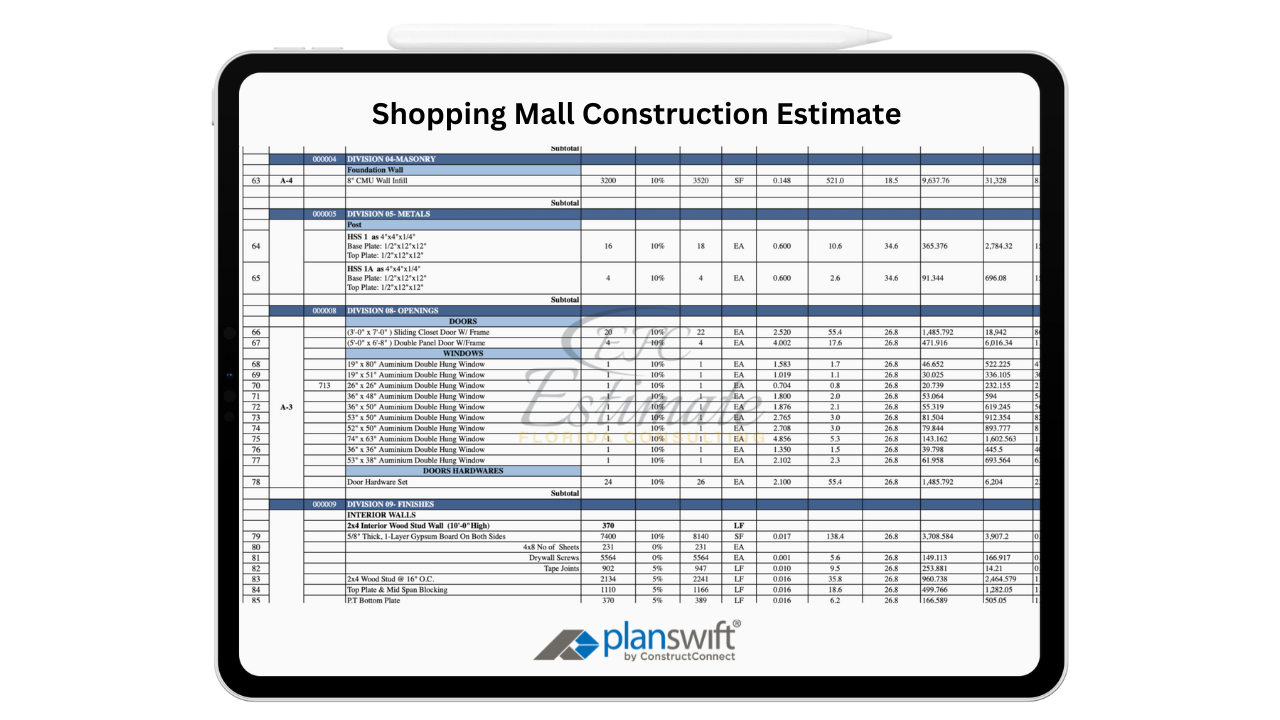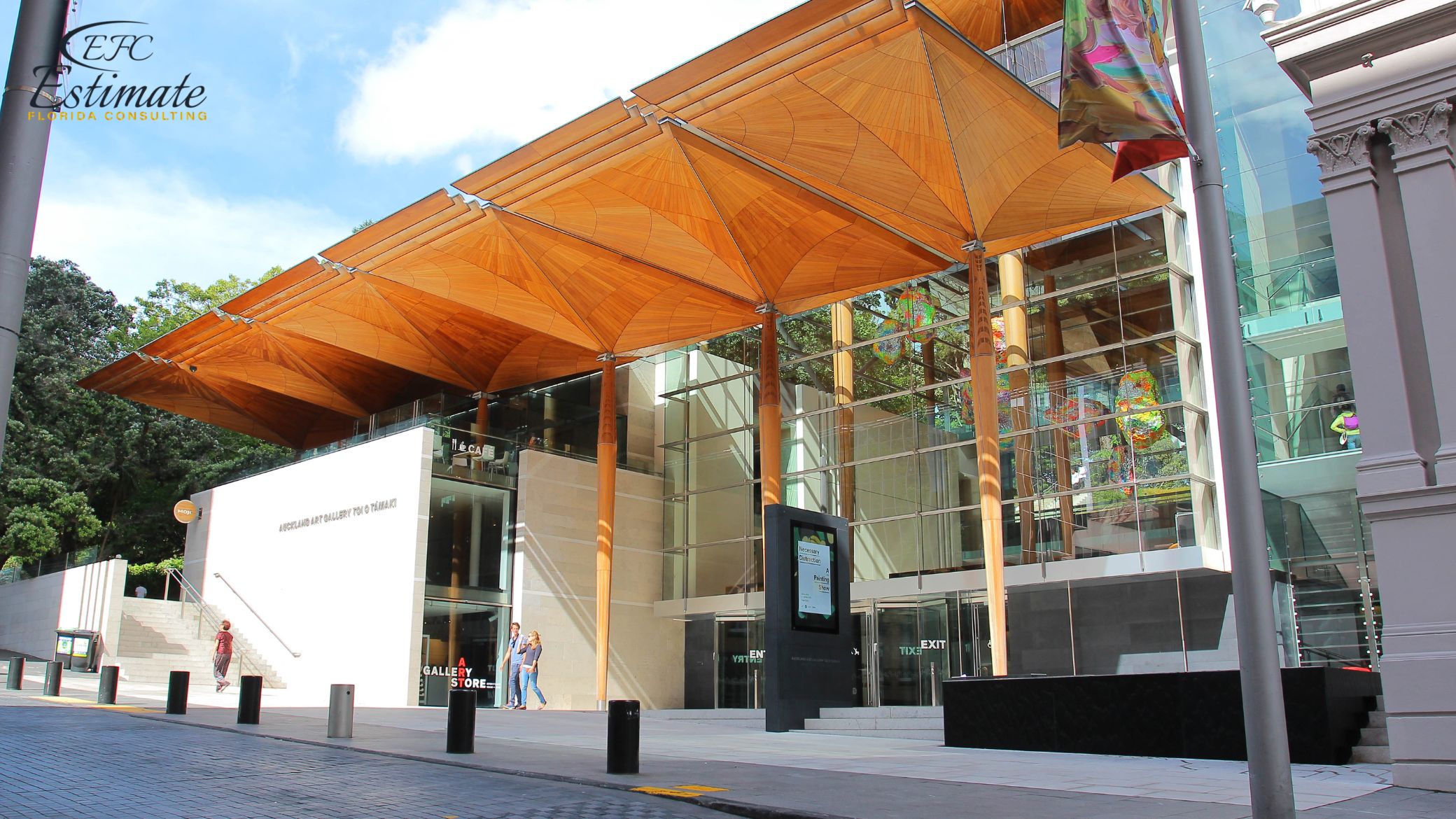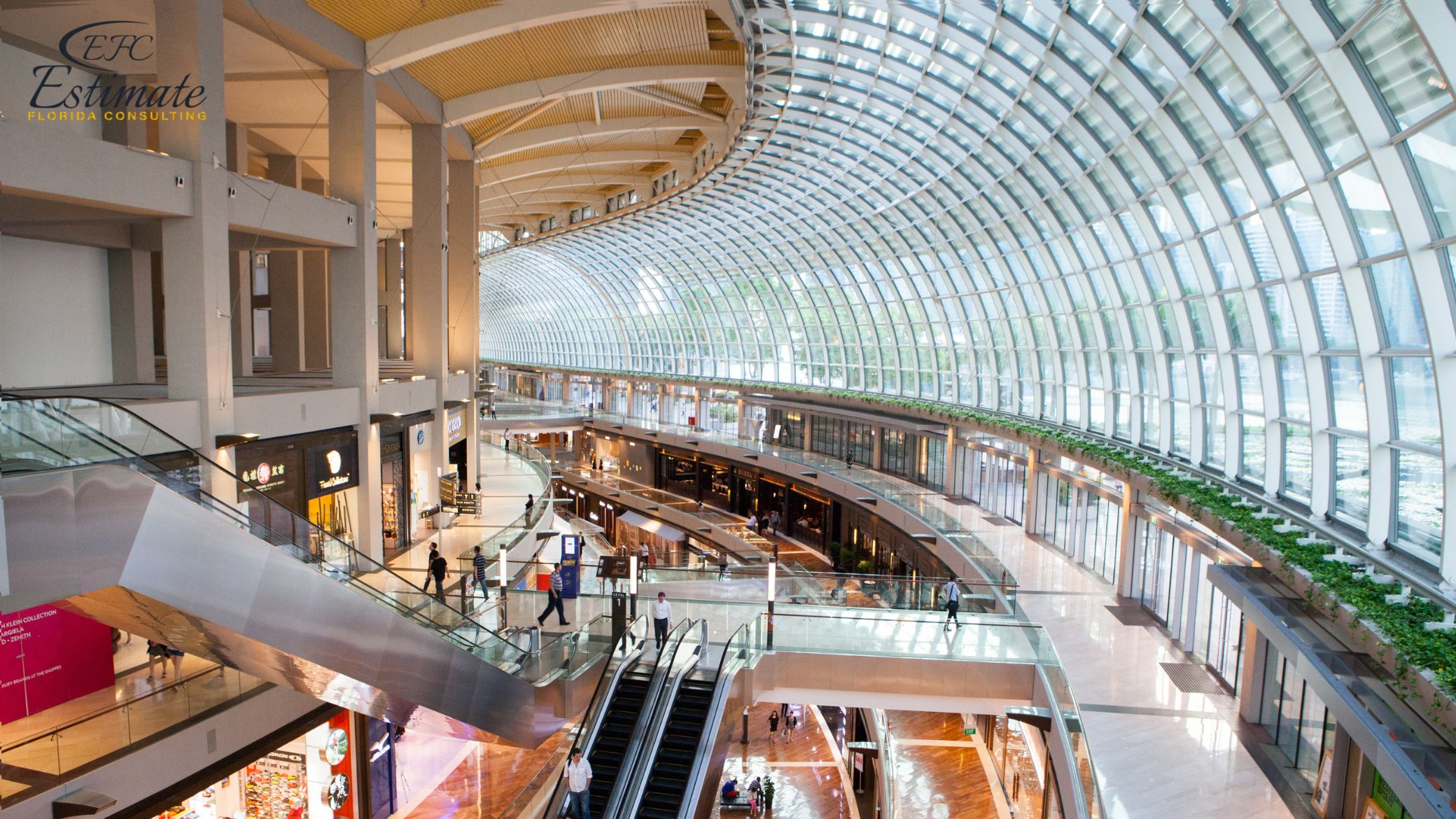- Homepage
- Construction in Palm Beach
Shopping Mall Construction in Palm Beach
Leading provider of shopping mall construction services.
Palm Beach, a dynamic urban hub celebrated for its vibrant culture and pivotal role as a gateway to international trade and tourism, is experiencing a rising demand for shopping malls. With its affluent population, booming tourism industry, and limited land availability, the city necessitates innovative retail solutions to serve its bustling commercial districts, luxury residential areas, and iconic tourist destinations like South Beach, Brickell, and the Design District. Constructing a shopping mall in Palm Beach requires meticulous planning and precise cost estimation to meet both economic goals and the city’s unique environmental challenges, including hurricane risks and flooding. At Estimate Florida Consulting, we specialize in delivering comprehensive cost analyses and tailored estimates to guide developers through this complex process.

Estimated Shopping Mall Cost Breakdown
The cost to build a shopping mall in Palm Beach varies widely based on size, location, design complexity, and features, averaging $350 to $650 per square foot or approximately $25 million to $350 million for projects ranging from small neighborhood centers to super-regional malls. Below are actual cost ranges for different mall types based on recent Palm Beach-specific data and industry benchmarks, adjusted for 2025 conditions:
- Neighborhood Strip Mall (10,000 sq. ft., 1 anchor): $3,500,000 – $6,500,000
- Regional Mall (250,000 sq. ft., 2-3 anchors): $87,500,000 – $162,500,000
- Super-Regional Mall (500,000 sq. ft., 4+ anchors, entertainment): $175,000,000 – $350,000,000+
These estimates reflect Palm Beach’s high land costs (often exceeding $1 million per acre in urban zones), fluctuating material prices (e.g., concrete at $120-$180 per cubic yard), and specialized engineering needs driven by local regulations and climate.
Construction Challenges in Palm Beach
Building shopping malls in Palm Beach presents distinct obstacles that elevate costs and complicate timelines:
- Hurricane and Flood Risks: Structures must endure Category 5 winds (up to 175 mph) and rising sea levels, requiring reinforced concrete, steel framing, and elevated foundations or flood-proof designs.
- Groundwater Issues: Palm Beach’s porous limestone bedrock and high water table make subterranean elements—like parking or basements—costly and risky, as evidenced by delays in projects like American Dream Miami.
- Permitting Delays: Miami-Dade County’s stringent zoning and environmental permitting process can extend timelines by 3-6 months, adding holding costs of $50,000-$200,000.
- Labor Market: A shortage of skilled workers in South Florida, fueled by construction booms, increases labor rates by 10-15% above national averages (e.g., $30-$50/hour for skilled trades).
Primary Factors Influencing Shopping Mall Construction Costs
Several key factors shape the cost of shopping malls in Palm Beach, varying with project scope and local conditions. Understanding these—size, location, materials, design complexity, and additional features—ensures accurate budgeting and efficient execution. Below, we explore these drivers in detail.
90% More Chances to Win Projects With Our Estimate!
- Multi-Family Building
- Hotel Building
- Hospital Building
- Warehouse Building
- School & University Building
- High-Rise Building
- Shopping Complex
- Data Center Building

Size of the Shopping Mall
Larger malls demand more materials, labor, and infrastructure, significantly impacting costs. Multi-level designs or expansive footprints amplify expenses further.
- Material Demand: More square footage increases concrete, steel, and glass usage.
- Labor and Equipment: Bigger projects require additional workers and cranes.
- Site Prep: Larger sites need extensive grading and utilities.
Cost to Build a 250,000 sq. ft. Regional Mall
Mall Size | Cost Range | Influencing Factors |
250,000 sq. ft. (2-3 anchors) | $87,500,000 – $162,500,000 | Location, materials, design, urban premiums |
Location of the Shopping Mall
Palm Beach’s geography and economic landscape significantly drive construction costs, with location playing a pivotal role in budgeting. Prime areas like Downtown or Aventura demand steep land prices due to their high desirability and limited availability, while suburban zones like Miami Lakes, though more affordable, often incur higher transportation expenses for materials and equipment.
- Land Cost: Urban sites range from $1M-$5M+ per acre.
- Labor Rates: Palm Beach’s competitive market pushes wages higher.
- Transportation: Materials shipped to remote sites add $2-$5 per sq. ft.

Materials Used in Construction
Material choices balance cost, durability, and Palm Beach’s climate demands. Reinforced concrete and steel dominate, with glass facades adding aesthetic value.
- Material Cost: Concrete ($120-$180/cu. yd.), steel ($1-$2/lb.), glass ($10-$20/sq. ft.).
- Durability: Hurricane-resistant materials increase upfront costs but reduce repairs.
Best Materials for Shopping Malls
Material | Cost per Sq. Ft. | Key Benefits |
Reinforced Concrete | $70 – $120+ | Strength, hurricane resistance |
Steel Frames | $60 – $100+ | Flexibility, large spans |
Glass Facades | $80 – $150+ | Aesthetics, natural light |
Design and Architectural Complexity
Simple strip malls cost less, while elaborate designs with atriums or mixed-use elements spike expenses.
- Basic Designs: Single-story layouts save on structural costs.
- Complex Designs: Multi-level or luxury finishes add $50-$100 per sq. ft.
Additional Features and Amenities
Category | Cost Range |
Entertainment (e.g., theaters) | $1M – $10M |
Food Courts | $500,000 – $2M |
Sustainability (e.g., solar) | $100,000 – $1M |
Contingencies | 5% – 15% of total |
3D Rendering Cost for a Shopping Mall
The cost of 3D rendering for a shopping mall varies based on factors such as project scale, complexity, level of detail, rendering quality, and turnaround time. Basic exterior renderings typically start at $1,000 to $3,500, while high-quality, photorealistic 3D visualizations with detailed interiors can range from $5,000 to $25,000 or more. Custom animations, VR walkthroughs, and advanced lighting effects can further increase costs. Hiring experienced 3D artists or agencies ensures precision, realistic visuals, and an efficient workflow, enhancing the marketing and presentation of large-scale retail developments.
We Provide 3D Rendering Services!
For Shopping Mall and Other Projects
Turnaround time is 1-2 days.
Win More Projects With Us
Shopping Mall Construction Cost Breakdown in Palm Beach
Category | Cost Range |
Land Acquisition | $1M – $5M+ per acre |
Site Prep & Foundation | $20 – $80 per sq. ft. |
Structural Construction | $200 – $400 per sq. ft. |
Roofing/Facades | $30 – $70 per sq. ft. |
Interior Finishing | $50 – $150 per sq. ft. |
Permitting & Legal | $50,000 – $500,000 |
Additional Costs | 5% – 15% of total |
Parking Lot Costs for Shopping Malls
Material | Cost per Sq. Ft. | Total Cost (10,000 sq. ft.) | Lifespan |
Asphalt | $6.60 – $13.20+ | $66,000 – $132,000+ | 10-15 years |
Concrete | $13.20 – $19.80+ | $132,000 – $198,000+ | 20-30 years |
Permeable | $15.84 – $26.40+ | $158,400 – $264,000+ | 15-25 years |
Trends Shaping the Future
- Sustainability: Solar panels and green roofs reduce costs long-term.
- Mixed-Use: Retail with residential or office spaces boosts revenue.
- Entertainment: Theaters and experiential zones attract visitors.
90% More Chances to Win Shopping Mall Bids with Our Estimate
The Growing Demand for Shopping Malls in Palm Beach
Palm Beach’ appeal as part of South Florida’s thriving trade and tourism landscape is fueling a strong demand for shopping malls, driven by its robust economy and proximity to global markets. With a growing population and rising consumer spending in this upscale city—alongside nearby areas like Aventura and Downtown Miami—malls are transforming from traditional retail hubs into dynamic, experiential destinations tailored to modern preferences.
- Adaptation to Trends: Palm Beach malls are integrating shopping with entertainment, dining, and leisure to draw in residents and visitors alike.
- Key Areas: Neighborhoods like Palm Beach stand out with high foot traffic and spending, alongside Aventura and Downtown Miami.
- Economic Boost: Palm Beach benefits from Greater Miami’s status as a trade and tourism gateway, supporting innovative retail growth.
Shopping Mall Cost by Type in Palm Beach

Cost per Sq. Ft. and Total Cost to Build a Mall by Type
Type | Average Cost per Sq. Ft. | Average Range |
Strip Mall | $240 – $360 | $2.1M – $4.2M |
Neighborhood Shopping Center | $300 – $360 | $3M – $12M |
Theme Mall | $300 – $360 | $3M – $24M |
Community Shopping Center | $300 – $360 | $6M – $30M |
Factory Outlet | $300 – $360 | $7.2M – $36M |
Power Center | $300 – $360 | $12M – $42M |
Lifestyle Shopping Center | $420 – $480 | $12M – $60M |
Regional Mall | $360 – $480 | $42M – $180M |
Super Regional Mall | $480 – $600 | $120M – $300M |
Role Of Professionals for Shopping Mall Construction
- Contractors: Oversee the entire shopping mall construction project, ensuring high-quality work, managing materials, labor, and timelines while adhering to safety regulations. Hire experienced contractors to ensure a durable, functional, and aesthetically appealing retail space.
- Subcontractors: Specialize in critical tasks such as electrical systems, plumbing, HVAC, lighting, fire safety, and structural work to enhance safety, comfort, and operational efficiency. Hire skilled subcontractors for precise execution tailored to shopping mall requirements.
- Architects: Design functional, visually appealing, and space-optimized shopping malls that comply with safety codes, traffic flow requirements, and accessibility standards. Hire professional architects to create a well-planned, engaging, and customer-friendly retail environment.
- Engineers: Ensure the structural integrity, durability, and efficiency of the shopping mall by planning and overseeing mechanical, electrical, and civil components. Hire expert engineers to develop a robust and sustainable structure that meets modern retail and entertainment demands.
- Construction Estimators: Provide accurate cost assessments for materials, labor, and project timelines to help optimize budget planning and prevent cost overruns. Hire professional estimators to ensure financial efficiency and project feasibility.
Get 5 New Projects in the Next 7 Days With Our System
4 Important Cost Saving Tips
- Optimize Design and Layout: Simplify the design with a functional layout, using modular or prefabricated components to minimize complexity and reduce material and labor costs.
- Choose Cost-Effective Materials: Source local or alternative materials (e.g., concrete instead of premium stone) and repurpose recycled options to cut expenses without sacrificing durability.
- Streamline Construction Processes: Use prefabrication for faster assembly and phase construction to spread costs, leveraging early tenant revenue to fund later stages.
- Reduce Energy and Utility Costs: Incorporate energy-efficient features like LED lighting and natural lighting to lower both construction and long-term operational expenses.
Conclusion
Constructing a shopping mall in Palm Beach is a complex yet rewarding endeavor, driven by the city’s thriving economy, tourism appeal, and growing population. However, the unique challenges of high land costs, hurricane risks, and regulatory hurdles demand careful planning and innovative strategies to keep projects financially viable. By optimizing design, selecting cost-effective materials, streamlining construction processes, and integrating energy-efficient features, developers can significantly reduce costs without compromising quality or functionality. As Palm Beach continues to evolve into a global retail and entertainment hub, the future of its shopping malls lies in blending sustainability, mixed-use development, and experiential attractions. With precise cost estimation and a focus on efficiency, developers can capitalize on Palm Beach’s dynamic market, delivering iconic retail destinations that meet both economic and environmental demands.
Question Answer
Frequently Asked Question
The time it takes to build a mall typically ranges from 2 to 4 years, depending on its size, complexity, and location. The process includes planning, securing permits, designing, and construction. Larger, more complex malls with multiple levels, luxury stores, and extensive amenities may take longer. Factors such as weather, labor availability, and unforeseen delays can also impact the timeline.
The average lifespan of a shopping mall is typically around 30 to 40 years, although this can vary based on location, maintenance, and market trends. Over time, malls may require renovations, upgrades, or repurposing to stay relevant as consumer preferences and retail landscapes change. Some malls may last longer with constant renovations, while others may be repurposed or redeveloped if they become less profitable.
The income from owning a mall can vary greatly depending on factors like size, location, tenant mix, and overall foot traffic. Typically, mall owners earn revenue through rental income from tenants (e.g., retail stores, restaurants, and entertainment venues), as well as common area maintenance fees.
On average, the annual revenue can range from $10 million to $50 million for large malls, though this can be much higher for premium locations or shopping centers with strong retail demand. Profit margins vary, but owners generally aim for a return on investment (ROI) between 6% and 12%. The profitability of mall ownership also depends on operational costs, including maintenance, security, and property management.
While owning a mall can be lucrative, the market is shifting, with many traditional malls facing challenges due to online shopping and changing consumer habits.
The size of the land required for a mall depends on the type and scale of the mall. Here's a general breakdown:
- Small Mall: A smaller shopping center or community mall may require 5 to 10 acres of land.
- Medium-Sized Mall: For a regional mall, the land requirement can range from 20 to 40 acres.
- Large Mall: A larger, high-end or destination mall may need 50 to 100 acres or more, especially if it includes entertainment facilities, multiple levels, parking, and other amenities.
- The exact acreage also depends on factors such as the number of stores, parking spaces, and amenities like restaurants or cinemas. Additionally, zoning regulations and local planning restrictions can influence the required land size.
The cost to build a small strip mall typically ranges from $2.1 million to $4.2 million, with an average cost per square foot between $240 and $360. The final cost depends on factors like location, construction materials, and the size of the mall.
The most profitable type of mall is typically a luxury or high-end mall, often referred to as a premium shopping center. These malls tend to attract affluent customers and host luxury brands and high-end retailers.
Construction Professionals For Your Project?
- Electrical
- Plumbing
- Masonry
- Roofing
- Painting
- More

